‘Bokhara Plains’
Reaching the real potential of the NSW Rangelands
A REGENERATIVE AGRICULTURE CASE STUDY
 Graham and Cathy Finlayson have used stock to convert claypans to pastures, significantly improving their carrying capacity, while diversifying into cattle trading and tourism to drought-proof their property, Bokhara Plains.
Graham and Cathy Finlayson have used stock to convert claypans to pastures, significantly improving their carrying capacity, while diversifying into cattle trading and tourism to drought-proof their property, Bokhara Plains.
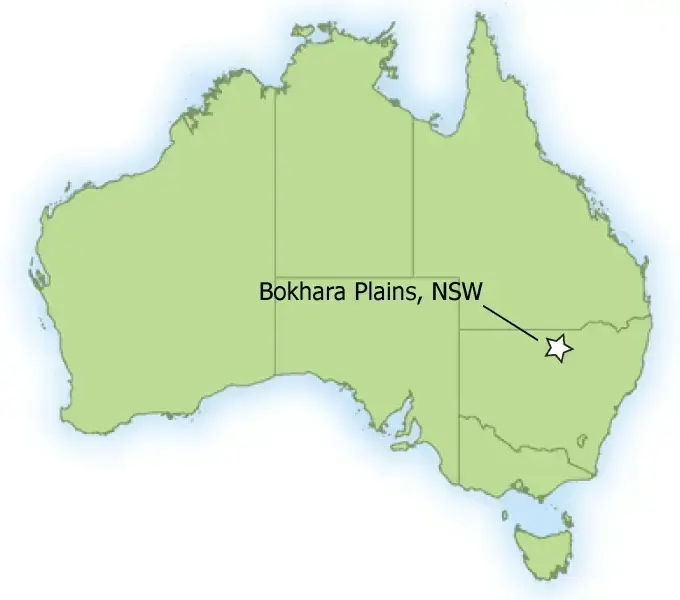
35 km north of Brewarrina, NSW North West
FARM FACTS
ENTERPRISE: Cattle, tourism. Beef cattle agistment and trading; accommodation and event venue
PROPERTY SIZE: 7200 hectares
AVERAGE ANNUAL RAINFALL: 380 mm
ELEVATION: 115m
MOTIVATION FOR CHANGE: Identifying the potential to improve the landscape and production
INNOVATIONS
- Using stock to break up claypan
- Holistic Management techniques to regenerate the rangeland
- Stock trading to balance stocking rate with pasture availability
- Diversifying into tourism
- Innovations commenced: 2001
KEY RESULTS
- Carrying capacity almost doubled to over 100 DSE days per hectare per 100mm rainfall
- Revegetation of claypan landscape
- Strong, positive community relationships
Introduction
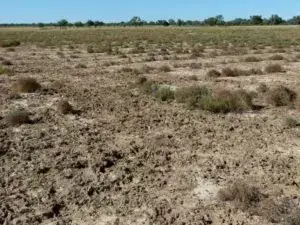
Disturbed surface and early claypan regeneration.
When Graham and Cathy acquired Bokhara Plains in 1999 they accepted that the property was run down. Ground tanks were bogging sheep every summer, they needed to cut scrub for fodder to keep sheep alive and large areas of the property were claypans. But they felt that things should be better than they were.
Graham and Cathy turned this belief into action after identifying potential in the claypans from observing new plant growth where the surface had been disturbed. Stock were eventually used to break up the claypans, allowing water to penetrate and seeds to germinate. Combined with Holistic Management techniques, the claypans are now being reverted to productive, pastured rangelands with an increasing carrying capacity. Further diversifying into cattle trading and tourism to ensure that they remain viable regardless of the rainfall, Graham and Cathy are well on the way to reaching the real potential of the NSW rangelands, and are providing a shining light for others to follow
Seeing the Potential
Bokhara Plains is located on the Goodooga road some 35km north of Brewarrina, NSW. The property has frontage on the Bokhara and Birrie Rivers, tributaries of the Barwon River and is part of the Murray Darling Basin and the Western Catchment Management Authority.
The property was traditionally farmed for wool production based on the sparse seasonal pasture growing on the flood plains of the two rivers.
When Cathy and Graham took over the property in 1999, about 50% of the area was claypan or otherwise bare ground. The claypans added nothing to the feed potential of the property. Even in good seasons, the land had struggled to maintain one of the lowest stocking rates in the district.
Graham realised that merinos were not profitable in this environment, and set stocking without matching numbers to carrying capacity was exacerbating ecological problems in the landscape. He explains, “We were almost totally reliant on my wife and I both working off farm to make ends meet. Continually running into dry periods and wishing / praying for rain was having a terrible emotional effect on my mental attitude, and a feeling of helplessness seemed to prevail”.
“I had read Allan Savory’s book on Holistic Management and realised that we could change the way we did things. One of two things drives fundamental change – pleasure or pain – and for me it was pain!”
Potential in the landscape was identified after the former owners carried out work on some of the claypans. A 400mm high bund was graded to form large shallow ponds. The theory of this method was that the water would soften the clay seal and allow seed to germinate.
The impact of ponding on the claypans was minimal but Graham noticed that there was significant growth on the edges of the claypans where the surface had been disturbed.
Graham states, “In 2001 the place was pretty well degraded and the whole ecological system had broken down. I felt that if we could restore the health of the rangeland that it could withstand drought… low rain in a healthy system could still be productive. It seemed to me that rangeland science was about understanding how the rangeland currently works, not about trying to change or improve it”.
Graham chose to build on the former owner’s ponding operations, initially by using their small Ferguson tractor to mimic the use of a larger grader, and then later using a mouldboard plough to break up the hard capped surface. At this point, he did not have the numbers of cattle that he needed to create the disturbance necessary, and recognised that using a small tractor, although relatively economical, was not nearly as efficient or effective as using cattle. Particularly someone else’s cattle.
Graham eventually identified that regeneration of the claypans and planned rotational grazing could allow the property to develop into productive rangeland with prolific native grasses and herbage suitable for cattle grazing. Agisting cattle allowed Graham to increase his numbers, which he then used to break up the surface of the claypans.
The results were significant, with earlier colonisers like copper burr (Sclerolaena spp.) responding quickly to the changed conditions, followed in due course by a variety of native grasses spreading over the bare surface.

Left: Grass seeds in disturbed claypan. Right: Regeneration of early coloniser, copper burr.
Realising the Potential
In achieving the potential they envisaged on Bokhara Plains Graham recognised that claypans were not a natural formation and could be restored to rangeland. Combined with Holistic Management principles, Graham determined that rangelands would respond positively to managed grazing practices, using livestock as partners.
After reading Allan Savory’s book, Graham undertook a RCS Grazing for Profit course followed by four years in the Executive Link program. “We also became inaugural participants in a program called Enterprise Based Conservation (EBC) through which we accessed some financial help to undertake a significant water and fencing project for much better control of grazing management.” This pilot program was run by WEST2000 Plus and included a five-year conservation agreement on land placed under voluntary conservation management.
Graham and Cathy also undertook major changes in their livestock enterprises, moving from sheep breeding to trading, then to agistment sheep to agistment cattle and now also cattle trading. They specialised in the larger herbivores from 2007 when they recognised that cattle were giving much better ecological and management benefits.
Graham follows three guiding principles for Bokhara Plains:
- Match the stocking rate with the carrying capacity of the land.
- Plants need adequate recovery.
- Monitor what is going on across the property, make plans, then manage against these plans.
Infrastructure Changes
Graham and Cathy planned their infrastructure around their grazing strategies. The fencing forms a number of ‘wagon wheels’ with a watering point at the hub, producing a number of ‘cells’. For additional fencing to match stocking rates to carrying capacity, they rely on electric fencing supplied from an inverter connected to mains supply at the house.
Pasture recovery before returning with livestock is paramount…
Fencing was initially based on the original infrastructure but Graham has modified the layout to reflect his requirement that stock should preferably not travel more than 1.5km to access water. On Bokhara Plains fencing cost about $400 a kilometre for material and labour. Graham points out that the cost can be recovered in a year with increased production from the planned rotational grazing and Holistic Management strategies. Much of the labour for fencing was on-farm, comprising Graham, Cathy and their daughter, Harriett.
Stocking
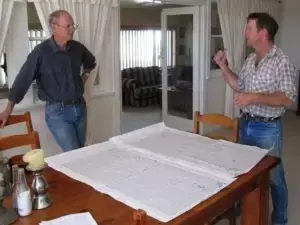
Graham discussing his stock trading chart
Graham and Cathy plan their grazing on availability of pasture at any one time. Graham explains, “Agistment is the basis of our operations and we trade against the variation of available pasture. Pasture recovery before returning with livestock is paramount, along with creating the ‘beneficial impact’ described previously. We monitor pasture availability and plan and manage against that”.
The agistment runs at $/head/week basis for 6-12 months. Stock trading is used to balance the agistment with pasture availability. Stomach and skin parasites are not an issue in the region and stock are not drenched or treated for lice.
In their stock trading operations, Graham and Cathy use strategies developed by Bud Williams in the USA, and now taught by KLR Marketing in Australia. These are based on keeping the three inventories of price, available pasture and stock holding in balance. Using a ‘sell-buy’ process rather than a ‘buy-sell’ process, in the balanced inventory context, they can decide on selling and re-stocking options.
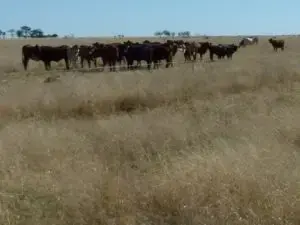
Increased pasture availability has enabled a significant increase in stocking rates
Graham and Cathy use a 12 month rolling rainfall figure to calculate the stocking rate per hectare by month and annually per 100mm of rain. Using this method, they can reduce stock accordingly when conditions deteriorate and do not have to purchase feed. While they have de-stocked in earlier times, they are confident that they will not have to do so again.
Using these methods, stocking rates have increased exponentially on Bokhara Plains. Graham and Cathy have been measuring their stocking rate or DSE* days per hectare per 100mm of rain since 2002, and have seen their benchmark capacity lift from 56 DSE days per hectare to over 100.
Standing at a watering point where six paddock fences join, Graham points to a 60 hectare paddock with 1100 cattle spread throughout the tall grass, “That paddock would typically only carry about four head year round in a set-stocked operation”.
Water Management
Graham acknowledges, “Water supply is the limiting factor for our grazing enterprise”.
Plan as if there will be no rain, then adjust when it does arrive!
Previously, Bokhara Plains had a very poor water cycle, with substantial runoff from the bare eroding soils. Livestock water was all supplied through open ground tanks, and the two river systems that transect Bokhara Plains, had a long history of set stocking.
Graham’s current sources are the two rivers and access to a bore. The rivers do not always flow, but when it is at high flow he stores water from the Bokhara River in a dam. Both rivers have now been fenced off to allow for strategic grazing. The old ground tanks have been blocked off or fenced in, and 35km of poly pipe has been laid to nine poly tanks and troughs. Water from the dam is pumped to stock watering points. The header tanks at the water points gravity feed to the troughs.
Graham structures his grazing plan around water availability and understands how much water is required on a daily basis per 1000 head of cattle. He works on his principle of, “Plan as if there will be no rain, then adjust when it does arrive!”

The waterpoints are the ‘hub’ for multiple paddocks in the wagon-wheel design. They are high-use areas when accessible (left), but the pasture can recover after rest (right)
Soil
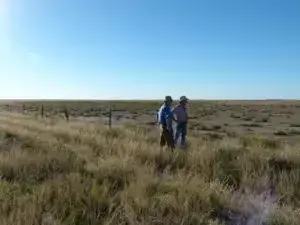
Improving the soil has enabled increased ground cover and nutrient cycling – visibly different to remnant claypan
The soils across Bokhara Plains, which have not yet been subject to soil testing, are varied. The country off the Bokhara and Birrie rivers comprises typical black soils, with lighter Mitchell grass (Astrebla spp.), Neverfail (Eragrostis setifolia), Queensland bluegrass (Dichanthium sericium) and bladder saltbush (Atriplex vesicaria) country interspersed with scalded claypans in between the rivers.
Claypans are a dense, compact, slowly permeable layer in the subsoil with a much higher clay content than the overlying material. The subsoil claypan layer becomes exposed when original topsoil is lost or degraded, exhibiting very different physical properties and behaviour. Claypans are usually hard when dry, and plastic and sticky when wet. They limit or slow the downward movement of water through the soil.
The techniques applied by Graham however, have enabled the bare ground to be converted to productive rangeland. The vastly increased ground cover has demonstrably increased overall soil biological activity, particularly the visible beneficial decomposing fungal activity in the soil, which regenerates healthy topsoils. Reducing paddock size and the successful grazing strategies are pointing towards potentially even higher stocking rates and therefore towards greater soil fertility as animals spread more dung and seed.
Vegetation Management
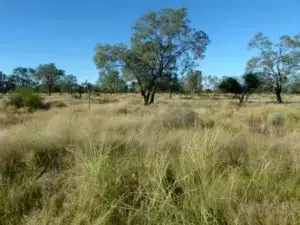
Vegetation diversity and coverage has significantly increased
At acquisition, the Bokhara Plains was a dustbowl. Approximately 50% of the total land area was bare ground, and aerial photographs showed huge areas of claypan. However, there were reasonable patches of Mitchell grass and bladder saltbush in places. Besides providing some basic stock feed, this existing vegetation provided a seed bank.
The WEST2000 Plus Project on EBC, that predated the intervention of the CMA, was aimed at increasing ground cover. The project paid on percentage of ground cover achieved. Graham and Cathy had a personal target of 70%, although the EBC target was 40% which is recognised as a critical threshold point to stop wind and water erosion, and was measured in the most likely month for being dry – October. Graham and Cathy noticed that the areas of high-impact grazing recovered better and they could see that, over time, stocking rates could be increased. They amended their own target to “100% ground cover 100% of the time”, and although difficult to achieve, Graham believes it should be every land managers goal whatever the environment. It had become obvious to Graham and Cathy that grazing strategies had to be part of their vegetation management and enterprise-based conservation.
The planned rotational grazing practices have given young trees and shrubs respite from literally being ‘nipped in the bud’. Independent monitoring from the beginning of the EBC Project has shown a steady increase in the number of native trees, increased ground cover and the presence of perennial grasses.
They also noticed that the best gains came from improving good land and not necessarily from regenerating claypan. They therefore concentrated their efforts on the good land first.
Weeds were not previously a significant concern on Bokhara Plains, and now, besides small and decreasing outbreaks of Bathurst Burr (Xanthium spinosum), which they deal with by hand, there are no appreciable weed and pest issues on the property
Diversifying
Graham and Cathy are admirers of the Joel Salatin approach of many synergistic enterprises stemming from the one farm. Aligned with this approach they have a willingness to diversify with complementary enterprises. One such enterprise has seen the development of a tourism venture ‘Bokhara Hutz’, which they have grown over the last ten years into a reliable source of income, particularly through the four separate occasions when they have totally de-stocked the property.
This successful 30 person capacity farm stay business also provides a venue for local events, such as weddings and parties. Plans for the future include generating more farm produce, to be less reliant on off farm purchases.
Cathy notes, “Our diversification into tourism has allowed us to reach toward our goal of drought proofing our business”.
A Shining Light on the Farm
The infrastructure design and layout, the ready availability of water to stock, the rested and fresh pastures and the careful management of all farm operations combine for exemplary Holistic Management practices. This is a far cry from when Graham and Cathy took over six dusty paddocks and a flock of struggling sheep in 1999.
Graham summarises, “This has so far been a ten year learning process, which we expect to continue for some time yet. Installing infrastructure, etc., was implemented with some financial help through the EBC project involvement, however much of our innovation has been off the back of work done by many friends, colleagues and other people I’ve met while learning and studying all over the world [Nuffield Scholarship 2008], due to their desire and preparedness to share their own experiences”.
Our potential to improve our ecological resource, particularly in the semi-arid areas, is far greater than conventional rangeland science understands or accepts
Through intensive cattle grazing using agistment and trading to give flexibility in numbers, Graham and Cathy have revegetated and rejuvenated a much degraded landscape. “We have taken Bokhara Plains from a six paddock extensive layout with poor water security, to a 100 plus paddock planned cell system with fully reticulated and controlled water system. We have also diversified into tourism / accommodation, and have hosted many farming tour groups in our facility, Bokhara Hutz.”
Graham and Cathy’s original goal was to develop their property to be able to run around twice the original estimated 56 DSE days per hectares per 100mm of rainfall. They now see that the potential is much greater, perhaps up to three to four times that DSE rate, whilst continuing to build positive environmental outcomes. These increases are possible, due to the resilience in their pastures through increased diversity of their ground cover and improvements in soil health brought about by their grazing management. Their profitability is now based on a sell/buy approach, where the ups and downs of the markets are smoothed out. And to provide further surety, a careful balance between agistment operations and a trading herd is maintained.
Graham points out that the “economics stack up” – the potential for increased production on the property is better than investing in more property.
“Often people in the area believe that expanding their land holding is the only way to survive in the light country of the region”, states Graham. “A quick cost benefit analysis suggests that this is not the case at all. Enterprises of our size can prosper. At a rate of around $12 per acre to establish water points and fencing will allow intensive grazing approaches to be established, with immediate improvement in the quality of pastures, percentage of ground cover and health of the stock. These improvements come with no additional overheads, unlike purchasing additional land at upwards of $100 an acre and the associated taxes and other costs.”
He continues, “And, it’s all about flexibility. You can’t manage without people and animals. Smaller places are the answer, not more land. We should make the most of what rain we get and develop the land we have. We always plan for no rain. If there is a rain event, then we re-plan”.
However, Graham laments, “Our potential to improve our ecological resource, particularly in the semi-arid areas is far greater than conventional rangeland science understands or accepts”. Reliance on science leading the way, with a lack of supporting policies and unreasonable bias against livestock, provides some of the greatest impediments to wider adoption of the sort of practices that are employed at Bokhara Plains. Indeed, Bokhara Plains is a shining light, in stark contrast to others seen around the landscape when driving through the west of NSW. For the Brewarrina area, a stocking rate of 4 head of cattle (24 DSE) to 60 hectares is considered suitable. That Graham can have 1100 head in that same area for two days might be considered by some to be ridiculous and not sustainable.
Graham points out that it is important to manage equity and debt levels against cash flow to ensure potential to increase carrying capacity and the possibility of increasing the margins from stock trading. In addition, in the context of all the activities, it is necessary to watch for ‘staff burn out’ and to employ additional labour at the right time.
For Graham and Cathy, reduced overheads through increased productivity and the use of contractors for specialised operations has contributed to more satisfying outcomes and better use of family time.

Graham’s practices are regenerative and enable a much greater stocking rate
… and in the community
Graham and Cathy note, “Since we first had a change in thinking back in 2001 we have endeavoured to be able to help others achieve the same. Our view is that we want to live in a more profitable farming environment, with more neighbours not less, and in a community that is not struggling or welfare reliant”.
Graham is an active mentor to others in developing their enterprises to more sustainable grazing and enjoys the opportunity to encourage others through both mentoring and education programs.
Many people who attend various training courses that educate people on the possibilities of changing what they do, still find it difficult to take the first step when they return to the farm. Support needs to be provided to people to help them on their way. This fact has been recognised by the Western CMA who has ‘hired’ successful grazing course graduates to mentor locals to assist them in their transition.
…we want to live in a more profitable farming environment, with more neighbours, not less, and in a community that is not struggling…
Many people who attend various training courses that educate people on the possibilities of changing what they do, still find it difficult to take the first step when they return to the farm. Support needs to be provided to people to help them on their way. This fact has been recognised by the Western CMA who has ‘hired’ successful grazing course graduates to mentor locals to assist them in their transition.
Graham is considered a role model for other farmers in the wider region wishing to consolidate their formal grazing management training, through his Western CMA sponsored mentoring of four farming business. This activity includes on-farm visits and teleconferencing to help his clients focus on outcomes, not issues.
Graham’s training was based on the RCS Grazing for Profit course and this program allows for expansion of this support through a well developed extension program.
Graham and Cathy now enjoy many social benefits from the enterprise. Bokhara Plains has hosted ‘Keep In Touch’ days for graduates of earlier grazing management courses, and field days (including hosting his mentors – Allan Savory and Terry McCosker at different times). On these days around 150 people, many of them young farmers, eager to learn and talk about a wide range of challenges both on farm and more strategically are able to share experiences.
Cathy remarks that one of the clear positive community aspects of their lives now is the opportunity to sit down at dinner most nights with a wonderful and varied group of people from all walks of life.
Graham was adjudged the NSW Young Farmer of the Year in 2005, relatively early in the transformation of Bokhara Plains, and has gone on to be recognised with Carbon Cocky and CMA awards.
Graham and Cathy have been involved in the P & F at a local school, the Rural Financial Council, and in the local Show and Rodeo committee. They also host an annual visit to Bokhara Plains by the Warringah school group as part of a sister city relationship with Brewarrina.
The Bokhara Hutz accommodation package has also delivered welcome benefits for the family. Cathy and Graham both enjoy the opportunity to interact with their visitors and interested farming groups coming to visit the property. “It provides another opportunity to show people what we have done over the years and to learn from those around the table.”



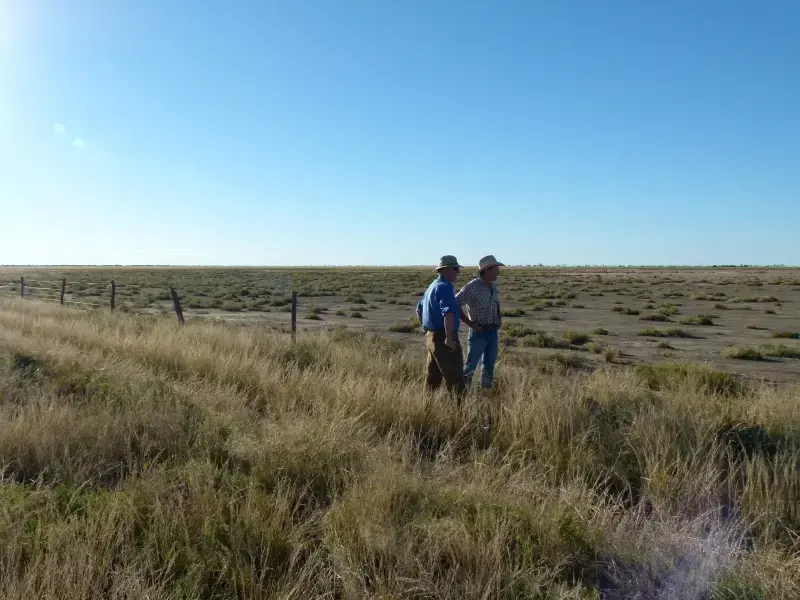
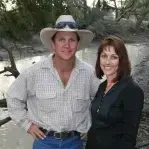 Graham and Cathy Finlayson have used stock to convert claypans to pastures, significantly improving their carrying capacity, while diversifying into cattle trading and tourism to drought-proof their property, Bokhara Plains.
Graham and Cathy Finlayson have used stock to convert claypans to pastures, significantly improving their carrying capacity, while diversifying into cattle trading and tourism to drought-proof their property, Bokhara Plains.
